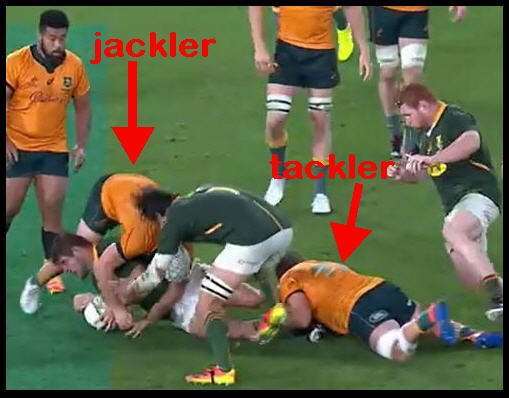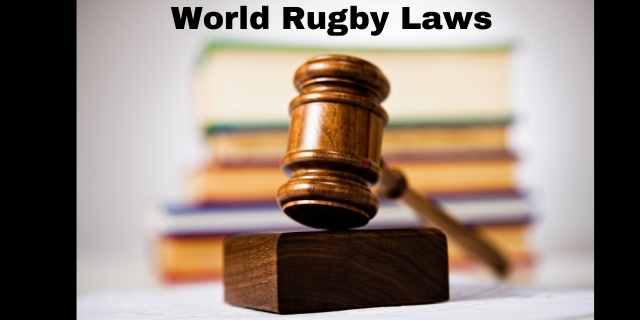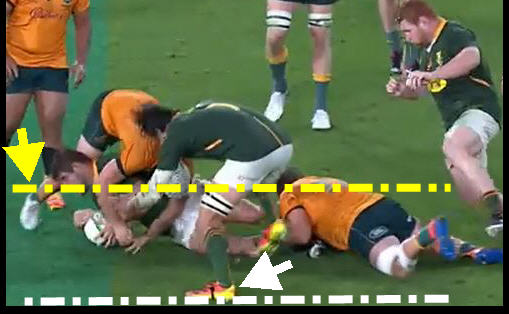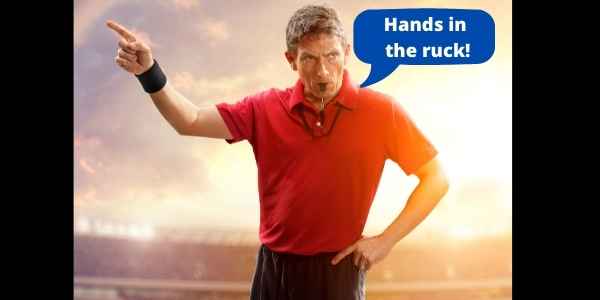A ruck in rugby occurs when the ball is on the ground and opposing players compete for it.
Because players have to stay on their feet, this can become a monumental struggle as players try to push their opponents backward and win possession.
It may seem like a free-for-all at times, but there are plenty of rules that apply when the ruck is formed, during the ruck, and after the ruck has finished. Read on for clear explanations.
How Does A Ruck Start?

A ruck starts after a player is tackled and the ball is on the ground. But a tackle doesn’t necessarily mean that a ruck will form.
When a ruck won’t start
Here are actions that ensure there will be no ruck at this tackle:
- the scrumhalf sweeps the ball away off the ground to a teammate.
- a teammate picks up the ball from the ground and runs forward
- the tackled player immediately pops the ball up to a teammate behind him
In all cases, the ball has been moved on from the tackle area without the opposition competing successfully.
This can be very advantageous for the attacking team. The ball keeps moving with the opposition scrambling on the back foot.
Notice that the last option of the pop-up pass must be “immediate”. The ball carrier can’t lie on the ground holding onto the ball until a teammate arrives to take a pass.
The rugby laws ensure that a tackled player must release the ball immediately. Referees will allow a half roll to place the ball behind, but there are limits.
You can check out our article on what kind of roll is allowed in rugby.
When the ruck starts
We’ve described three scenarios in which a ruck doesn’t form. So, let’s look at how and when it does.
When the ball isn’t moved quickly away from the tackle, the opposing team is entitled to compete for possession.
The ruck starts when two players engage and compete for the ball. But that’s the start of the ruck. When does the referee decide that the ruck is fully formed?
When Is A Ruck Formed?
Bear in mind that the tackler is probably also on the ground holding on to the ball carrier’s legs. This tackler isn’t allowed to compete for the ball on the ground. That would be a penalty.
Instead, the nearest teammate will attempt to ruck over the ball. The defender bends over the tackled player and keeps on his feet while fighting to get his hands on the ball.
This is clear in the picture below. The defender in yellow has leaned over to grab the ball on the ground. This fighting is known as “jackeling” and I’ve labeled the player as the “jackler”.

The Australian player in the scrum cap is Michael Hooper, a renowned jackler. (A jackler is a player who wins opposition ball at rucks).
Note that the South African player has bent over to try to shunt the Australian off the ball and grab it himself.
This is a clear competition between two players for the ball on the ground.
One player from each team has made contact while on their feet. The ball is on the ground (just) and the two players are positioned over it.
There is one more criterion for a ruck to be formed. Both players must keep their heads and shoulders at the same level or above their hips.
The jackler is treading a fine line in the picture above. But we can assume that he dropped his hips a second later to maintain the correct position.
This means that we have the definition of when a ruck is formed.
What the laws say

Here are the actual laws from the manual:
A ruck is formed when at least one player from each team are in contact, on their feet and over the ball which is on the ground.
Players involved in all stages of the ruck must have their heads and shoulders no lower than their hips.
World Rugby Laws
What Happens When A Ruck Is Formed?
When referees decide that a ruck is formed, they’ll usually alert the players by yelling “ruck formed” or “that’s a ruck”.
This is because there are some actions that players mustn’t do when a ruck is formed.
For example, nobody can kick the ball when the ruck is formed.
This is a relatively recent change that was brought in for player safety. Before the law change, you’d see defending players hacking away at the ball.
Ruck Offside Lines
There are strict rules that govern the other players who join their teammates to help the fight for possession.
Let’s say that there’s no ruck i.e. the ball is on the ground with nobody competing for it. There’s nothing to stop a defending player from approaching on a horizontal line and picking up the ball.
In contrast, when the referee has called “ruck”, there are now offside lines that govern how players from both sides can approach the ball. These are at the hindmost foot of the two competing players.
I’ve marked the two offside lines in the picture below. The top line marks the offside line of the defending team in yellow. His teammate standing behind him is onside. That player can join the ruck from his current position.

The bottom line in white shows the offside line that governs the teammates of the tackled player. The player in green to the right is in front of his team’s offside line.
He mustn’t run horizontally from this position to join the ruck. This is a penalty infringement.
Instead, the player must take a few steps backward to get behind the offside line. He can then join the ruck from an onside position.
Hands In The Ruck Explained

This is another shout you may hear from the referee: “hands in the ruck!”.
This is a penalty infringement.
You may be wondering why this doesn’t apply to the players in our earlier pictures.
In our example, the two competing players got their hands on the ball before the ruck had formed. Their engagement has caused the forming of the ruck.
It’s the other players who can’t fly in to grab the ball on the ground.
The players can join their teammates to push and ruck the opposition back off the ball. But they can’t touch the ball itself.
That doesn’t mean that a player won’t try a sneaky little flick of the ball towards their own side.
If the referee spots this? There’ll be a sharp whistle and a stern “hands in the ruck”.
Hands On The Ground In A Ruck
“Hands on the ground!” is another shout from the referee as a warning.
When players ruck over the ball, they’re not allowed place their hands on the ground to support their body weight. If a player has done so, the referee may warn him not to try to go for the ball.
Sometimes it’s very difficult to spot a player momentarily touching the ground and then grabbing the ball.
It’s an offence that can be missed, much to the howls of protest from the opposing team’s supporters!
Collapsing A Ruck
You’ll occasionally see a large forward flopping onto the ruck and flattening all and sundry.
This is known as “collapsing the ruck”. When the referee decides it’s intentional (e.g. the player wasn’t pushed or pulled), then this will be a penalty kick.
There are less obvious situations that players are more likely to try to get away with. They will try to drag one or more opposition players down to the ground and over the ball.
Their goal is to make the ball unplayable and hopefully be awarded possession in a scrum. However, the referee may decide that the player has intentionally collapsed the ruck. Penalty to the other team!
Obviously, collapsing rucks make the opposition unable to contest for the ball. That is an infringement.
But there is also a safety aspect with a pile of bodies collapsing on the necks and limbs of the guys at the bottom of the ruck.
When Is The Ball Out Of A Ruck?
After a ruck has been formed by two opposing players, their teammates aren’t allowed to grab or handle the ball while it’s in the ruck.
However, if the ball comes out of the ruck, it’s fair game.
The ball is out of a ruck when it moves past the hindmost foot of the players who have formed or joined the ruck.
Sometimes the ball is accidentally knocked or kicked by the team in possession so that it shoots away from the pile of bodies over it. The opposition players are entitled to rush forward and pick it up or jump on it.
But players are also watching for the scrumhalf to pick up the ball. The opposition players want to tackle the nine before he gets the ball away.
However, there’s a moment when the scrum half has hands on the ball but its still in the ruck. If the opposition move too soon, they will give away a penalty.
Rugby Quiz!
Think you know your rugby?
Let's see if you can match the quote to the player or coach!
Here are seven quotes. How well will you do?
